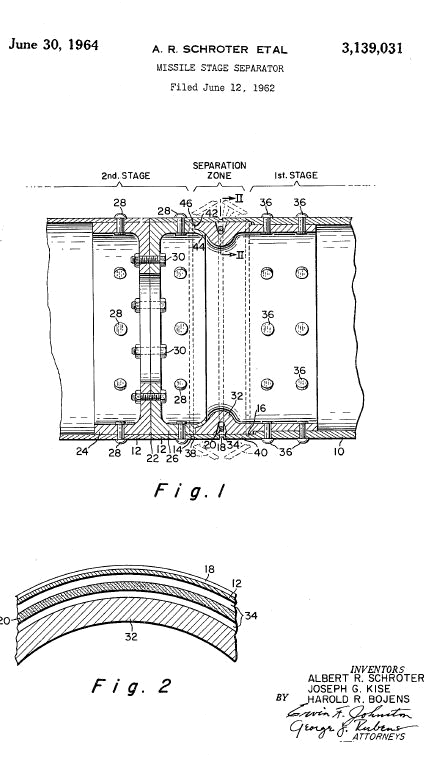|
The Start -
Every once in awhile we get a technical
book in the library with a signature in it. That book was ROCKET
PROPULSION ELEMENTS - An Introduction to the Engineering of Rockets
- by GEORGE P. SUTTON.
Looking up H.R. Bojens, the original owner,
proved to be interesting and there are a few article and a
patent for rocket separation device listed below. If
anyone has anything to add on Mr. Bojens please contact us at infor@smecc.org
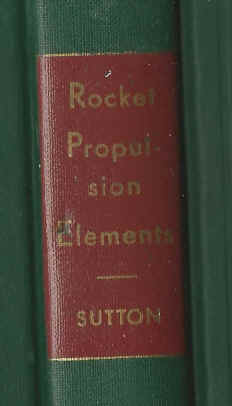 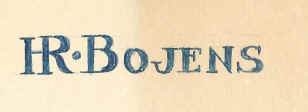
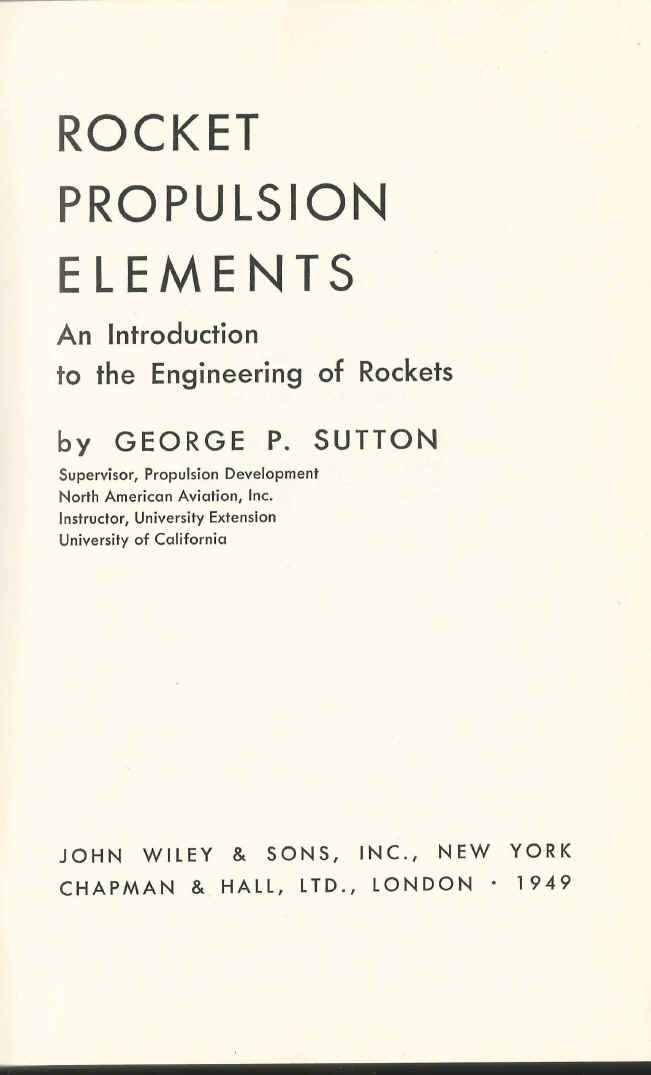
ROCKET PROPULSION ELEMENTS - An Introduction
to the Engineering of Rockets
by GEORGE P. SUTTON - Supervisor, Propulsion Development North American Aviation, Inc.
- Instructor, University Extension University of California
JOHN WILEY & SONS, INC., NEW YORK - CHAPMAN & HALL, LTD., LONDON • 1949
|
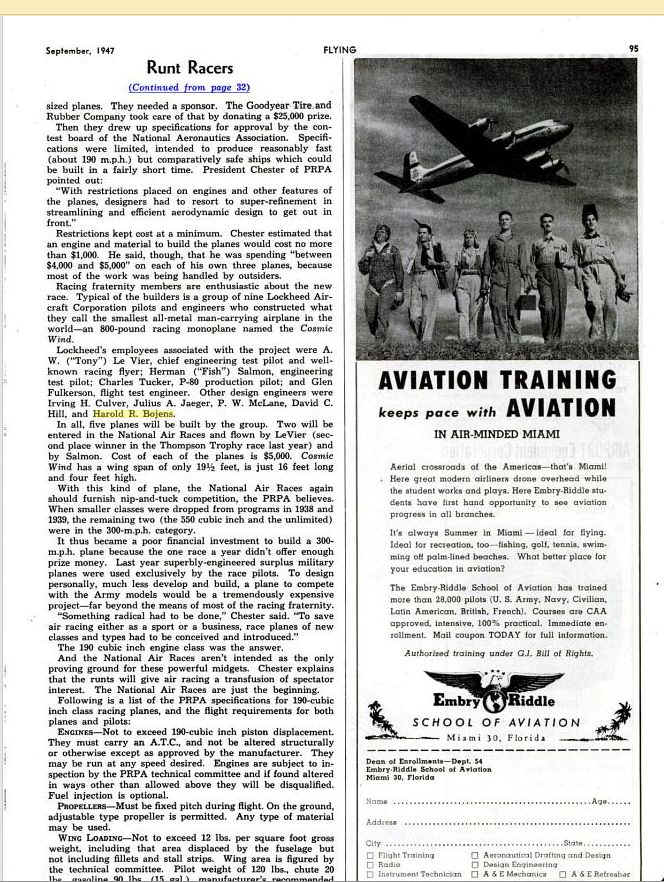
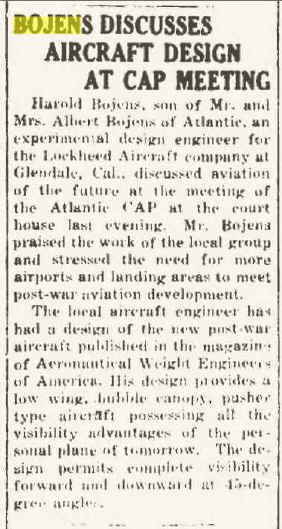
Atlantic News Telegraph Thursday April 26 1945 - Page 2
1940 Census Record
Age at Time of Census:
35
Enumeration District:
19-206
Residence:
Tract 402, Glendale, Glendale Judicial Township, Los Angeles, CA Map
Relationship to Head:
Head
Line 69
1940 U.S. Federal Population Census
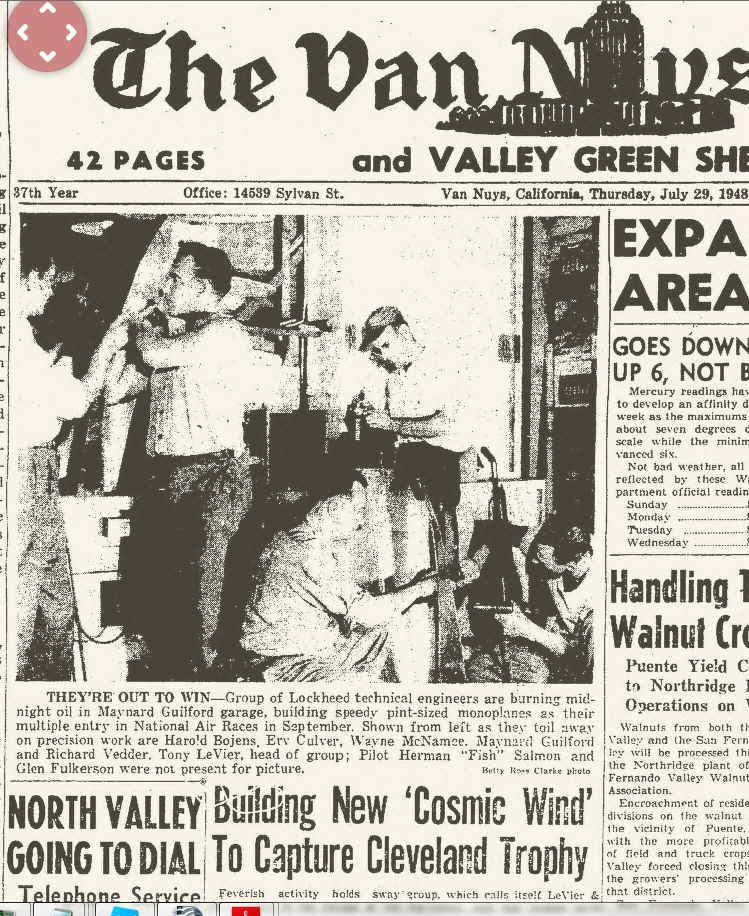
THEY'RE OUT TO of Lockheed technical engineers are burning mid- night
oil in Maynard Guilford garage, building speedy pint-sized monoplanes as
their multiple entry in National Air Races in September. Shown from left
as they toil away on precision work are Bojens, Erv Culver, Wayne McNamee.
Maynavd Guilford and Richard Vedder. Tony LeVier, head of group; Pilot
Herman "Fish" Salmon and Glen Fulkerson were not present for
picture.
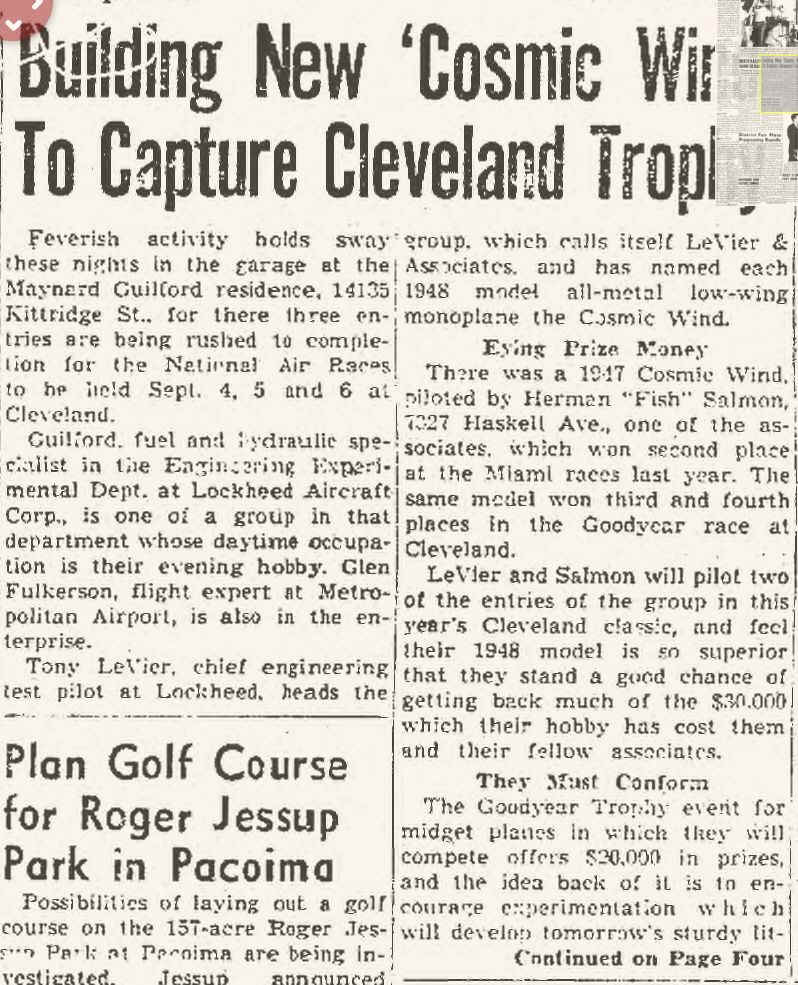
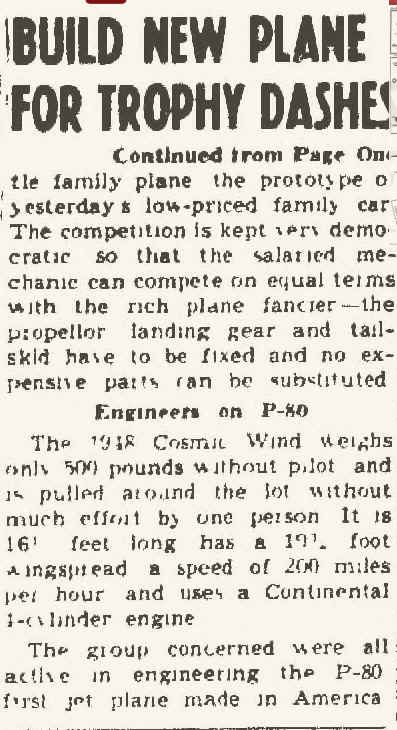
BUILD NEW PLANE FOR TROPHY DASHES Continued tram Page Onr tie family
plane the prototype of >esterdays low-priced famil> car The
competition is kept demo- cratic so that tho salaried me- chanic can
compete on equal teims with the rich plane piopellor landing gear and
tail- skid to be fixed and no ex- rxnsne paits tan be "iihstituted on
P-80 Th" i'jif Cosmic Wind onlv W) pounds vnthout p.lot and pullpd
aiound the lot without much effoit one peison It is 16' feet long has a
IT. foot Aingspiead a speed of 200 miles pel hour and uses a Continental
t-olmder engine Thf gioup concerned were all l aclhc in engineering the
P-80 j f'rst jet plane made in America
|
| Not sure which version had the 85 HP
engine but... here is what WIKI says...
LeVier Cosmic Wind
From Wikipedia, the free encyclopedia
Cosmic Wind
Cosmic Wind G-ARUL at the 2009 Cosford Air Show
Role Racing aircraft
National origin USA
Designer Tony LeVier
First flight c.1947
Number built 6
Variants American Electric Piranha
The LeVier Cosmic Wind was a small single engine, single seat racing monoplane designed and built by staff of the Lockheed Corporation in 1947. It did not race successfully in the US but one won the premier cross-country competition in the UK in 1964. It still flies today.
Contents [hide]
1 Design and development
2 Operational history
3 Specifications (85 hp engine)
4 References
5 External links
Design and development[edit]
The Cosmic Wind was designed and built by Lockheed's chief test pilot, Tony LeVier, and a group of Lockheed engineers.[1] A very small single-seat racer, it was aimed at the Goodyear Trophy for Formula 1 class racers initiated in the US soon after World War II.[2][3]
It is an all-metal low-wing cantilever monoplane. Wings and tail surfaces are all straight-edged and tapered. The ailerons are full span and carry trim tabs, as does the full-fin-depth rudder. The undercarriage is fixed, with streamlined main legs and wheels in long fairings. The roller tailwheel is tucked into the rear corner of the fuselage behind the rudder. The cockpit is enclosed with a small, single-piece, perspex canopy. The first aircraft were powered by 85 hp (63 kW) Continental C-85 horizontally opposed engines but more recently at least four[2][4][5][6] have used the 100 hp (75 kW) Continental O-200-A. The engine installation includes a large pointed spinner and long, bulbous cylinder head/exhaust fairings.[1]
Operational history[edit]
Cosmic Wind on display
Three Cosmic Winds were built at Lockheed's between 1947 and 1948 and a fourth rather later. A fifth was also built in the US by amateur constructors. The last example was built in the UK as late as 1972.[1] The type was not particularly successful in competitions in the 1940s,[2] coming only 3rd and 4th in the 1947 Goodyear Trophy races.[7] One example of the first three, named Ballerina and exported to the UK as G-ARUL, won the King's Cup Race of 1964;[1] it remains active in the UK, and is a regular participant in air displays.[5] The UK-built Cosmic Wind remains on the civil aircraft register as G-BAER, but currently (2010-10) lacks a Permit to Fly.[6]
In the USA, the amateur-built example is now in the EAA AirVenture Museum, Oshkosh, Wisconsin.[2] Another Cosmic Wind, built or modified with a shoulder rather than low wing, is in the Planes of Fame museum,[8] Chino.
Specifications (85 hp engine)[edit]
Data from Airlife's World Aircraft[1]
General characteristics
Crew: 1
Length: 16 ft 8 in (5.08 m)
Wingspan: 18 ft 11 in (5.77 m)
Height: 4 ft 3 in (1.3 m)
Max takeoff weight: 849 lb (385 kg)
Powerplant: 1 × Continental C85 air cooled horizontally opposed piston, 85 hp (63 kW)
Performance
Maximum speed: 185 mph; 161 kn (298 km/h)
Cruising speed: 160 mph; 139 kn (257 km/h)
Range: 318 mi; 276 nmi (512 km)
Rate of climb: 2,500 ft/min (12.7 m/s) initial
References[edit]
^ Jump up to: a b c d e Simpson, Rod (2001). Airlife's World Aircraft. Shrewsbury: Airlife Publishing Ltd. p. 328. ISBN 1-84037-115-3.
^ Jump up to: a b c d "Cosmic Wind at the AirVenture Museum". Retrieved 2010-10-04.
Jump up ^ "Formula One Racing". Retrieved 2010-10-05.
Jump up ^ "CAA documents, Cosmic Wind G-AYRJ". Retrieved 2010-10-04.
^ Jump up to: a b "CAA documents, Cosmic Wind G-ARUL". Retrieved 2010-10-04.
^ Jump up to: a b "CAA documents, Cosmic Wind G-BAER". Retrieved 2010-10-04.
Jump up ^ "1947 National Air Races". Retrieved 2010-10-05.
Jump up ^ "Miss Cosmic Wind at Collection -> Flying & Static Aircraft -> p.4". Retrieved 2010-10-05.
External links[edit]
Wikimedia Commons has media related to LeVier Cosmic Wind.
Flight International article on the Cosmic Wind from 1963
[hide] v t e
Lists relating to aviation
General
Aircraft manufacturers Aircraft engines manufacturers Airlines Defunct airlines Helicopter airlines Airports Aerobatic teams Civil authorities Gliders Museums Registration prefixes Rotorcraft manufacturers Timeline
Military
Air forces Experimental Missiles Unmanned Weapons
Accidents / incidents
Commercial airliners by location Fatalities by death toll General aviation Military By registration
Records
Airspeed Altitude Distance Endurance Firsts Large Most-produced aircraft Most-produced rotorcraft
Categories: United States sport aircraft 1940–1949Racing aircraft
Navigation menu
Create accountLog inArticleTalkReadEditView history
This page was last modified on 9 December 2014 at 19:46.
Text is available under the Creative Commons Attribution-ShareAlike License; additional terms may apply. By using this site, you agree to the Terms of Use and Privacy Policy. Wikipedia® is a registered trademark of the Wikimedia Foundation, Inc., a non-profit organization.
Privacy policyAbout WikipediaDisclaimersContact WikipediaDevelopersMobile view
|
